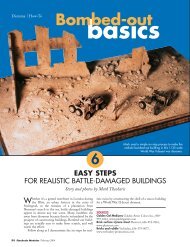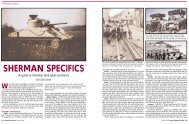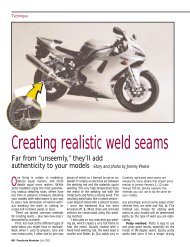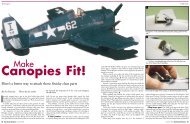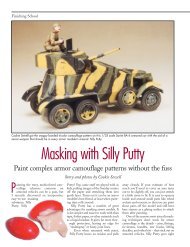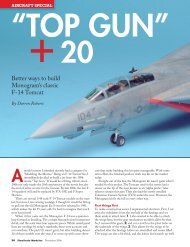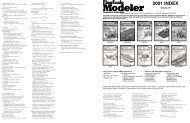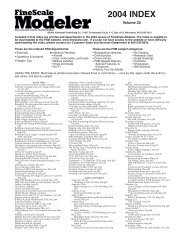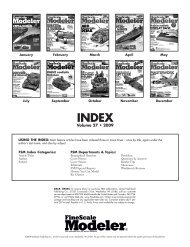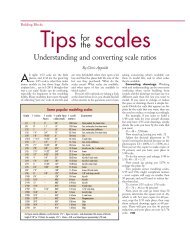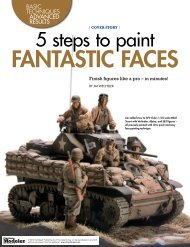Take on a Horten improvement project - FineScale Modeler
Take on a Horten improvement project - FineScale Modeler
Take on a Horten improvement project - FineScale Modeler
- No tags were found...
You also want an ePaper? Increase the reach of your titles
YUMPU automatically turns print PDFs into web optimized ePapers that Google loves.
Build Drag<strong>on</strong>’sHo-229A-1<str<strong>on</strong>g>Take</str<strong>on</strong>g> <strong>on</strong> a <strong>Horten</strong> <strong>improvement</strong> <strong>project</strong>Modeling by Ricardo DacobaFor Ricardo, Drag<strong>on</strong>’s 1/48 scaleHo 229A-1 was <strong>on</strong>ly the beginningof a fascinating story. He builtdetails he thought should be presentand added what he thought couldhave been.April 1945: As Patt<strong>on</strong>’s Third Army rolls through Germany, XIII Corps capturesthe Gotha aircraft plant at Friedrichsroda – and with it, fragmentary prototypesof a mysterious aircraft.It was the top-secret, highly experimental <strong>Horten</strong> <strong>project</strong>. Even if <strong>on</strong>e of theplanes had been fully assembled, it’s doubtful many of the American soldiers who saw itwould have known what to make of a plywood twin-engine jet with no tail, no fuselage,and no propellers. On a much smaller scale, the <strong>Horten</strong> 229 resembled the B-2 bomberfirst viewed by the public in 1988. But this was 1945 – imagine what Kilroy must havethought!A half century later, the Ho 229 still captures the imaginati<strong>on</strong> of modelers. And in thecase of Ricardo Dacoba, imaginati<strong>on</strong> and research led to details not found in Drag<strong>on</strong>’sHo 229 kit. No matter – armed with photos, drawings, and his own ideas of how thingsmight have turned out if the aircraft had entered service, Ricardo just kept building. FSM46 <strong>FineScale</strong> <strong>Modeler</strong> February 2007
7 8The real Ho 229 was mostly plywood, so thermal insulati<strong>on</strong> around theengines seemed appropriate. Ricardo rolled out two 1mm-thick sheets ofepoxy putty and shaped them to the c<strong>on</strong>tours of each engine.Ricardo repositi<strong>on</strong>ed the c<strong>on</strong>trol surfaces to pose them more realistically.9 10Another refinement was the installati<strong>on</strong> of sheet-styrene drag rudders.Ricardo got extra modeling mileage with the additi<strong>on</strong> of drop tanksscrounged from a Drag<strong>on</strong> Me 262.11 12For the nose gear, Ricardo scratchbuilt doors he thought made more sensethan the three-part affair supplied in the kit. He used <strong>on</strong>e of the kit’s doorsto make an RTV mold, poured a couple resin copies, and added them to theoriginal doors to match the length of the well.Ricardo armed his aircraft with X-4 missiles developed for the Me 262. Hecarved the missile bodies from balsa and cut the fins from sheet styrene;they’re painted RLM 02 grau and finished with clear gloss.48 <strong>FineScale</strong> <strong>Modeler</strong> February 2007
13 14One can <strong>on</strong>ly guess how the Ho 229 might have been painted for combat.Ricardo patterned the camouflage after the Me 262, airbrushing XtracolorX210 braunviolett (RLM 81) and X211 dunkelgrün (RLM 82) <strong>on</strong> the uppersurfaces, and X208 lichtblau (RLM 76) underneath.Panel lines are accented with dark-brown pencil. Ricardo held paper masksin place as he gently applied a weathering of windswept grime, airbrushinga thin wisp of Tamiya smoke at low pressure.REFERENCESGerman Aircraft Interiors, Vol. 1, K.A. Merrick, M<strong>on</strong>ogramAviati<strong>on</strong> Publicati<strong>on</strong>sM<strong>on</strong>ogram Close-Up 12: <strong>Horten</strong> 229, David Myhra, M<strong>on</strong>ogramThe <strong>Horten</strong> Brothers and Their All-Wing Aircraft, Myhra, SchifferPublishingSOURCESXtracolor enamels, www.hannants.co.ukUnimat1 hobby tool, www.thecooltool.comThe <strong>Horten</strong> Brothers’ NürflugelsGrowing up together in B<strong>on</strong>n, Germany, Walter andReimar <strong>Horten</strong> were fascinated with flight from boyhood<strong>on</strong>. Flying clubs and glider competiti<strong>on</strong>s were highly popularin the 1930s, and the teenage <strong>Horten</strong>s became perennialchampi<strong>on</strong>s, with Reimar’s nurflügel (<strong>on</strong>ly-wing)sailplane designs attracting attenti<strong>on</strong> from some ofGermany’s top aviators. The <strong>Horten</strong> 1, a wooden, singleseatglider piloted by Reimar, w<strong>on</strong> a 600 Reichsmarks prizefor original design in the summer of 1934. The Ho 2-Bfeatured a single 80-horsepower, pusher-type propeller, andseveral variants of the Ho V were twin-propeller craft. Allwere nurflügels.The logic behind all-wing designs was simple – minimizeaerodynamic drag while maximizing lift. The<strong>Horten</strong>s had been inspired by the tailless, delta-wingdesigns of fellow German Alexander Lippisch. In theUnited States, Northrop’s XB-35 “flying wing” wasawarded a $2.9 milli<strong>on</strong> c<strong>on</strong>tract in 1941.The <strong>Horten</strong> brothers had no such largesse – but perhapsmore ingenuity. As a combat pilot in the Battle ofBritain, Walter had seen for himself that Germany had nomatch for the British Spitfire. He was sure he and hisbrother could build a superior fighter. He took a seniorpositi<strong>on</strong> in the Jagdfluginspekti<strong>on</strong> (inspecti<strong>on</strong> of fighters) tocurry favor in Berlin for a new <strong>Horten</strong> prototype.Eventually – without authorizati<strong>on</strong> – Walter fabricated atop-secret command, using his security status and forgeddocuments to order materials and have Reimar transferredto his “unit.”The <strong>Horten</strong> designs showed promise. And there was anadditi<strong>on</strong>al benefit: The c<strong>on</strong>toured plywood aircraft was difficultto track <strong>on</strong> radar.C<strong>on</strong>structi<strong>on</strong> of the Ho 9, a twin-engine jet, was wellunderway in mid-1943 when Reichsmarshall HermannGöring called for a new fighter with a 1,000km range thatcould achieve 1,000km/h and carry a 1,000kg bomb load.The <strong>Horten</strong>s were granted an interview with Göring, whoordered a prototype to be delivered in six m<strong>on</strong>ths. Thedeadline was tight but not impossible – until the <strong>Horten</strong>slearned the BMW engines they had chosen were unavailable.Jumo 004 engines were substituted, but they werelarger, and the airframe had to be rebuilt. The newly designatedHo 229 didn’t fly until December 1944.Meanwhile, another complicati<strong>on</strong> arose. Withoutrevealing Germany’s atom-bomb program, Göringrequested an aircraft with an 11,000km minimum range todrop a 4,000kg bomb <strong>on</strong> North America. No other manufacturerwould attempt such an aircraft – but the <strong>Horten</strong>sproduced a design for a four-engine, all-wing “AmerikaBomber,” the <strong>Horten</strong> 18.It was not to be. In April 1945, the brothers were capturedby American troops. War-crime investigati<strong>on</strong>s followed,but the <strong>Horten</strong>s’ l<strong>on</strong>g-standing decepti<strong>on</strong>s servedthem well. Despite evidence of jet prototypes and highlevelassociati<strong>on</strong>s, by many accounts the <strong>Horten</strong>s had beennothing more than famous makers of sailplanes.– Mark HembreeFebruary 2007 www.finescale.com 49




